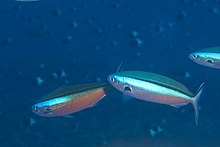Dark-banded fusilier: Difference between revisions
Quetzal1964 (talk | contribs) →Description: rewrite |
Quetzal1964 (talk | contribs) |
||
| Line 24: | Line 24: | ||
==Distribution and habitat== |
==Distribution and habitat== |
||
The dark-banded fusilier is widespread in [[Indo-Pacific]], from [[East Africa]] to the [[Tuamotu Island|Tuamoto Islands]], southern Japan, [[Mauritius]], and the [[Austral Islands]]. ''P. tile'' is a coral-reef associated species. It usually can be found in lagoon and on the reef flats at depths to {{convert|60|m|abbr=on}}.<ref name = Fishbase/> |
|||
==References== |
==References== |
||
Revision as of 16:21, 6 July 2021
| Dark-banded fusilier | |
|---|---|

| |
| Scientific classification | |
| Domain: | Eukaryota |
| Kingdom: | Animalia |
| Phylum: | Chordata |
| Class: | Actinopterygii |
| Order: | Perciformes |
| Family: | Caesionidae |
| Genus: | Pterocaesio |
| Species: | P. tile
|
| Binomial name | |
| Pterocaesio tile (Cuvier, 1830)
| |
| Synonyms[2] | |
| |
The dark-banded fusilier (Pterocaesio tile), also known as blue-streak fusilier, bluedash fusilier, or neon fusilier, is a species of marine ray-finned fish, a fusilier belonging to the family Caesionidae. It has a wide Indo-West Pacific range. It is of some importance to fisheries within its range.
Taxonomy
The dark-banded fusilier was first formally described as Caesio tile in 1830 by the French zoologist Georges Cuvier with the type locality given as the Caroline Islands.[3] When the Dutch ichthyologist Pieter Bleeker described Pterocaesio as a new genus in 1876 he used Caesio multiradiatus, a species described by the Austrian ichthyologist Franz Steindachner in 1861, as the type species. C. multiradiatus was subsequently considered to be a synonym of Cuvier's C. tile.[4] Kent E. Carpenter placed this species in the monospecific subgenus Pterocaesio in his review of the Caesionidae of 1987.[5] The specific name tile is the local name for this species in the Caroline Islands.[6]
Description
The dark banded fusilier has a fusiform, elongated and compressed body. There are small conical teeth in the jaws and on the vomer and palatines.[5] The dorsal fin contains 10-12 spines and 19-22 soft rays while the anal fin has 3 spines and 13 soft rays.[2] There are scales on both the dorsal and anal fins. There are 22-24 rays in the pectoral fins.[5] This species attains a maximum total length of 30 cm (12 in), although a standard length of 21.2 cm (8.3 in) is more typical.[2] The overall colour is brownish with each scale on the back having a white spot creating rows. The lower body is pink to reddish and there is a wide iridescent blue stripe extending from the snout to the caudal peduncle edged above by a thin black stripe reaching onto the upper lobe of the caudal fin. There is also a black spot on the base of the pectoral fin. They have the ability to quickly change colour, darkening to reddish below while shortening the blue stripe.[7] The dorsal fin is pale bluish green to pinkish and there is a black streak in the lower lobe of the caudal fin, separate from the black lateral stripe which runs onto the upper lobe.[2].
Distribution and habitat
The dark-banded fusilier is widespread in Indo-Pacific, from East Africa to the Tuamoto Islands, southern Japan, Mauritius, and the Austral Islands. P. tile is a coral-reef associated species. It usually can be found in lagoon and on the reef flats at depths to 60 m (200 ft).[2]
References
- ^ Carpenter, K.E.; Lawrence, A. & Myers, R. (2016). "Pterocaesio tile". IUCN Red List of Threatened Species. 2016: e.T20253151A65927672. doi:10.2305/IUCN.UK.2016-3.RLTS.T20253151A65927672.en. Retrieved 6 July 2021.
- ^ a b c d e Froese, Rainer; Pauly, Daniel (eds.) (2021). "Pterocaesio tile" in FishBase. June 2021 version.
- ^ Eschmeyer, William N.; Fricke, Ron & van der Laan, Richard (eds.). "Species in the genus Pterocaesio". Catalog of Fishes. California Academy of Sciences. Retrieved 6 June 2021.
- ^ Eschmeyer, William N.; Fricke, Ron & van der Laan, Richard (eds.). "Genera in the family Lutjanidae". Catalog of Fishes. California Academy of Sciences. Retrieved 6 July 2021.
- ^ a b c Kent E. Carpenter (1988). FAO Species Catalogue Volume 8 Fusilier Fishes of the World (PDF). FAO Rome. pp. 61–63.
- ^ Christopher Scharpf & Kenneth J. Lazara, eds. (5 January 2021). "Order LUTJANIFORMES: Families HAEMULIDAE and LUTJANIDAE". The ETYFish Project Fish Name Etymology Database. Christopher Scharpf and Kenneth J. Lazara. Retrieved 6 July 2021.
- ^ Bray, D.J. (2019). "Pterocaesio tile". Fishes of Australia. Museums Victoria. Retrieved 6 July 2021.
External links
- Photos of Dark-banded fusilier on Sealife Collection

